Abstract
In self-processing biochemical reactions, a protein or RNA molecule specifically modifies its own structure. Many such reactions are regulated in response to the needs of the cell by an interaction with another effector molecule. In the system we study here, specific cleavage of the Escherichia coli LexA repressor, LexA cleaves itself in vitro at a slow rate, but in vivo cleavage requires interaction with an activated form of RecA protein. RecA acts indirectly as a coprotease to stimulate LexA autodigestion. We describe here a new class of lexA mutants, lexA (Adg-; for autodigestion-defective) mutants, termed Adg- for brevity. Adg- mutants specifically interfered with the ability of LexA to autodigest but left intact its ability to undergo RecA-mediated cleavage. The data are consistent with a conformational model in which RecA favors a reactive conformation capable of undergoing cleavage. To our knowledge, this is the first example of a mutation in a regulated self-processing reaction that impairs the rate of self-processing without markedly affecting the stimulated reaction. Had wild-type lexA carried such a substitution, discovery of its self-processing would have been difficult; we suggest that, in other systems, a slow rate of self-processing has prevented recognition that a reaction is of this nature.
Full text
PDF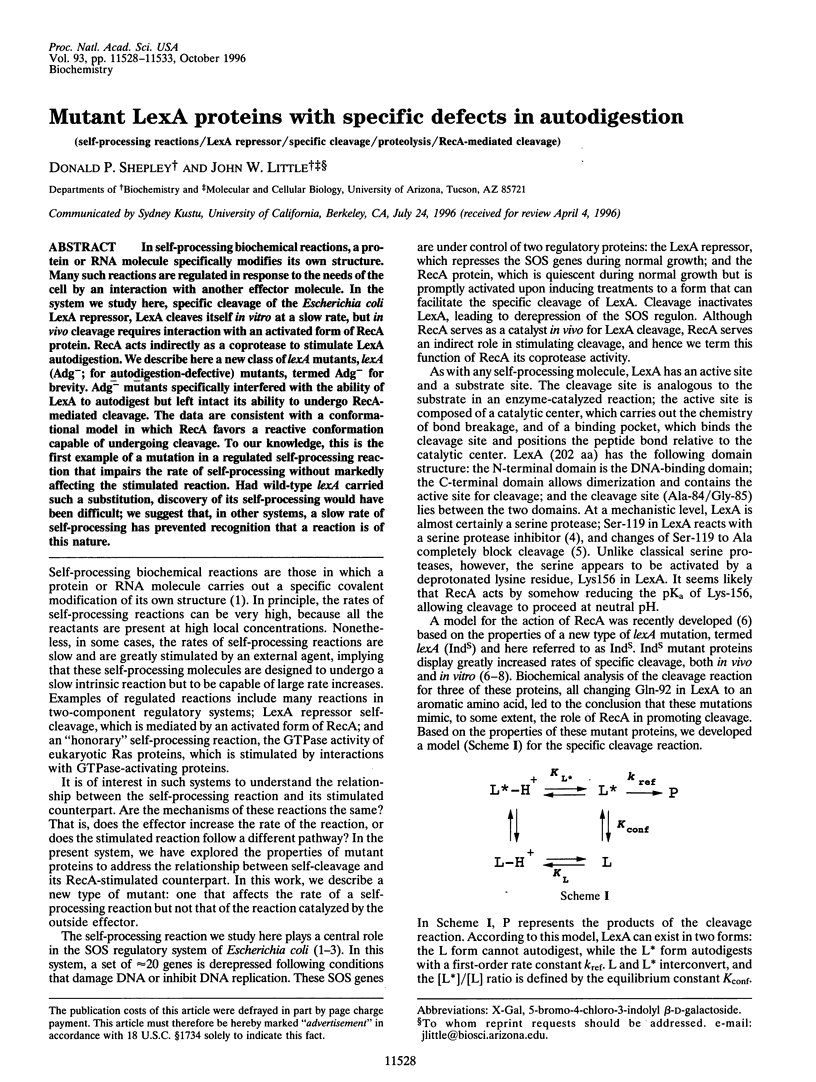
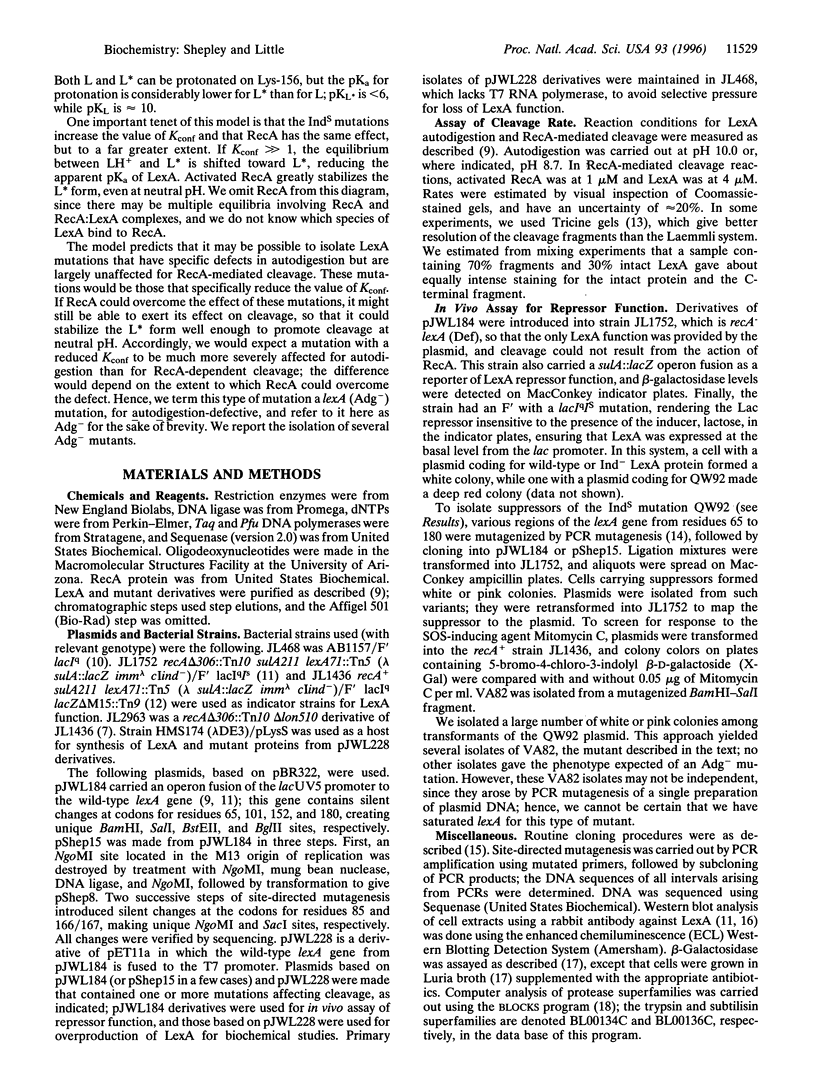
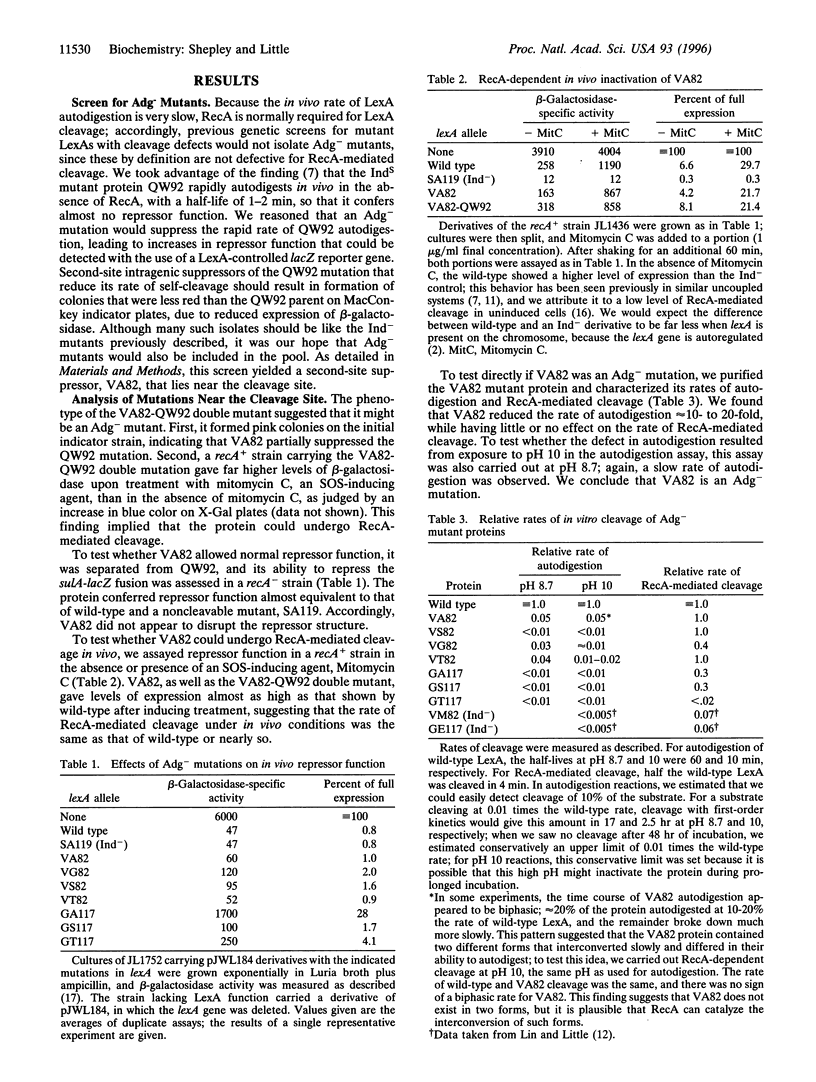
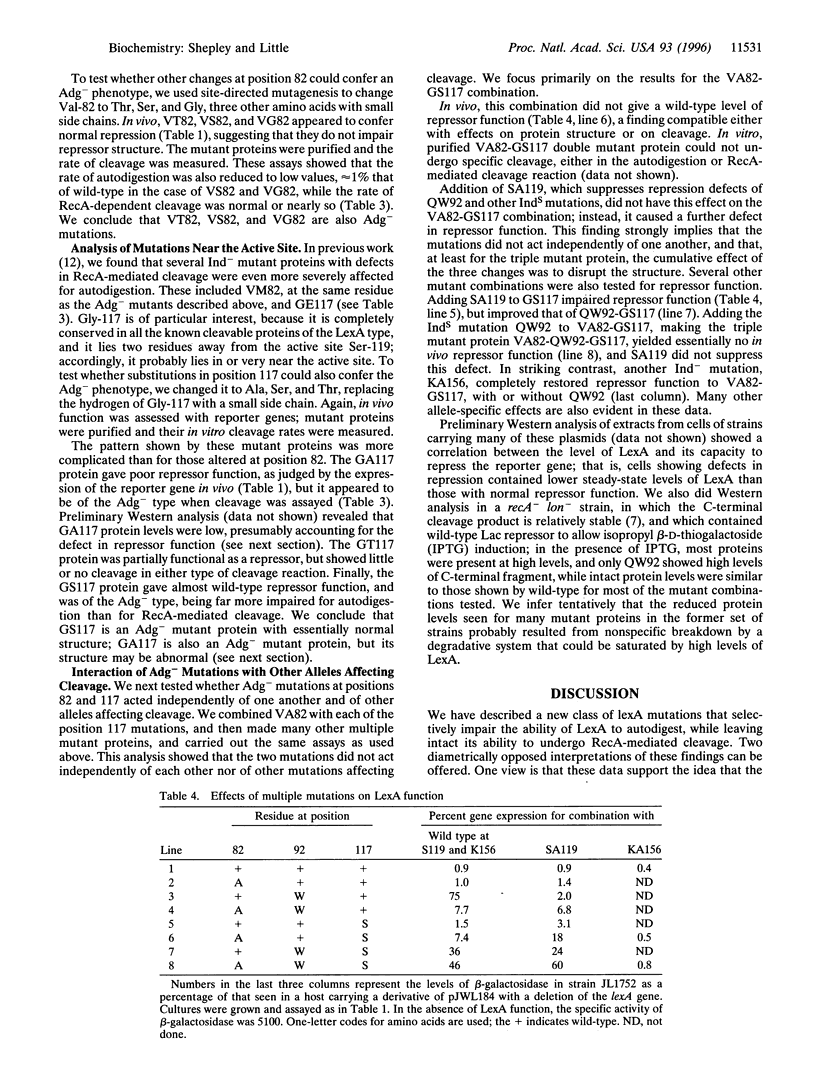
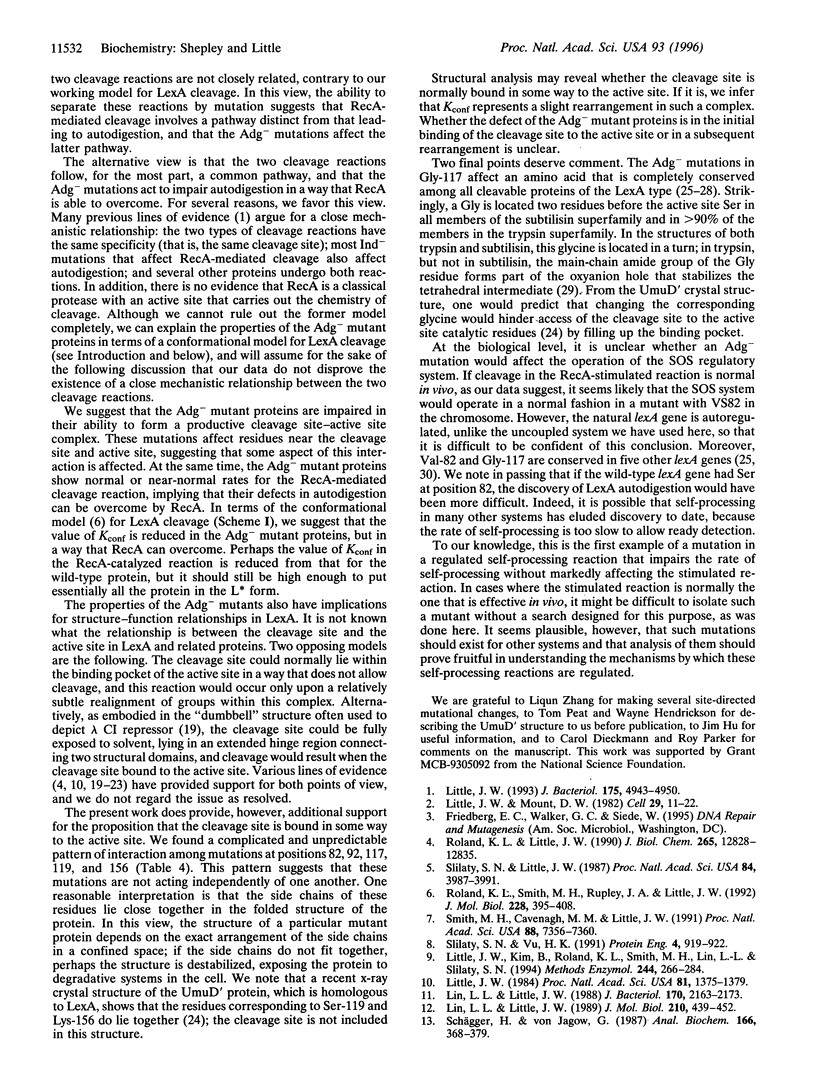
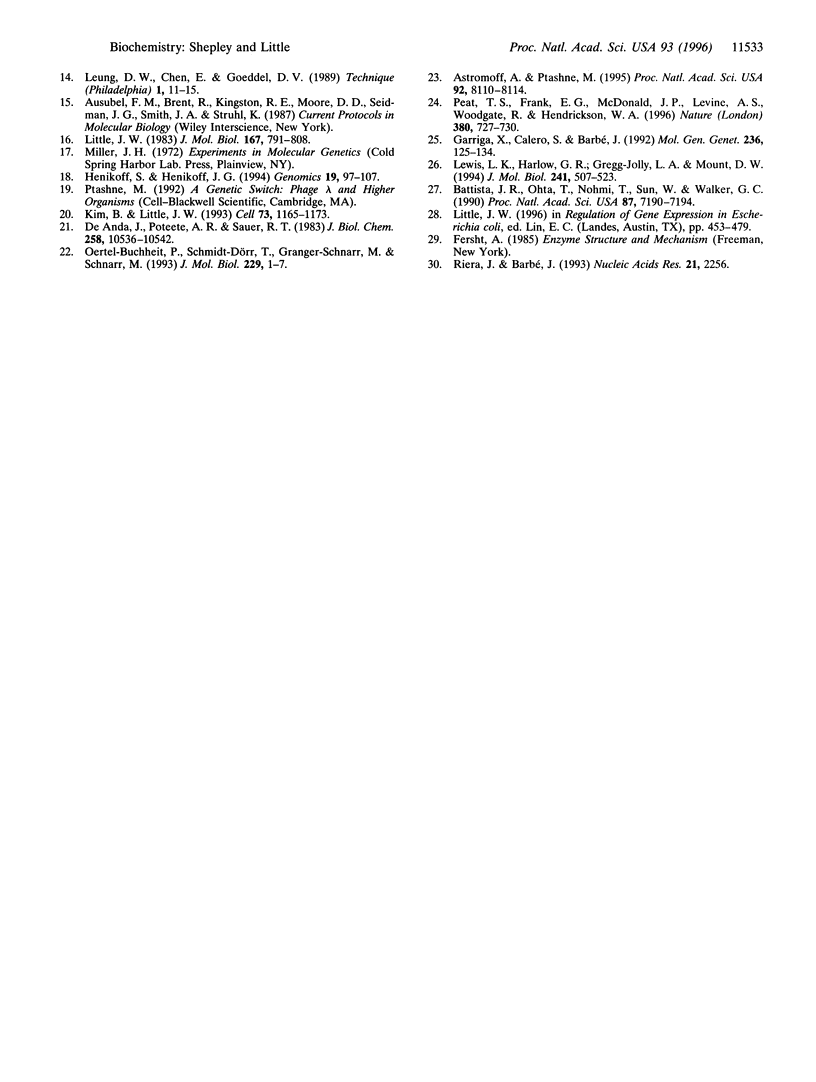
Selected References
These references are in PubMed. This may not be the complete list of references from this article.
- Astromoff A., Ptashne M. A variant of lambda repressor with an altered pattern of cooperative binding to DNA sites. Proc Natl Acad Sci U S A. 1995 Aug 29;92(18):8110–8114. doi: 10.1073/pnas.92.18.8110. [DOI] [PMC free article] [PubMed] [Google Scholar]
- Battista J. R., Ohta T., Nohmi T., Sun W., Walker G. C. Dominant negative umuD mutations decreasing RecA-mediated cleavage suggest roles for intact UmuD in modulation of SOS mutagenesis. Proc Natl Acad Sci U S A. 1990 Sep;87(18):7190–7194. doi: 10.1073/pnas.87.18.7190. [DOI] [PMC free article] [PubMed] [Google Scholar]
- De Anda J., Poteete A. R., Sauer R. T. P22 c2 repressor. Domain structure and function. J Biol Chem. 1983 Sep 10;258(17):10536–10542. [PubMed] [Google Scholar]
- Garriga X., Calero S., Barbé J. Nucleotide sequence analysis and comparison of the lexA genes from Salmonella typhimurium, Erwinia carotovora, Pseudomonas aeruginosa and Pseudomonas putida. Mol Gen Genet. 1992 Dec;236(1):125–134. doi: 10.1007/BF00279651. [DOI] [PubMed] [Google Scholar]
- Henikoff S., Henikoff J. G. Protein family classification based on searching a database of blocks. Genomics. 1994 Jan 1;19(1):97–107. doi: 10.1006/geno.1994.1018. [DOI] [PubMed] [Google Scholar]
- Kim B., Little J. W. LexA and lambda Cl repressors as enzymes: specific cleavage in an intermolecular reaction. Cell. 1993 Jun 18;73(6):1165–1173. doi: 10.1016/0092-8674(93)90645-7. [DOI] [PubMed] [Google Scholar]
- Lewis L. K., Harlow G. R., Gregg-Jolly L. A., Mount D. W. Identification of high affinity binding sites for LexA which define new DNA damage-inducible genes in Escherichia coli. J Mol Biol. 1994 Aug 26;241(4):507–523. doi: 10.1006/jmbi.1994.1528. [DOI] [PubMed] [Google Scholar]
- Lin L. L., Little J. W. Autodigestion and RecA-dependent cleavage of Ind- mutant LexA proteins. J Mol Biol. 1989 Dec 5;210(3):439–452. doi: 10.1016/0022-2836(89)90121-6. [DOI] [PubMed] [Google Scholar]
- Lin L. L., Little J. W. Isolation and characterization of noncleavable (Ind-) mutants of the LexA repressor of Escherichia coli K-12. J Bacteriol. 1988 May;170(5):2163–2173. doi: 10.1128/jb.170.5.2163-2173.1988. [DOI] [PMC free article] [PubMed] [Google Scholar]
- Little J. W. Autodigestion of lexA and phage lambda repressors. Proc Natl Acad Sci U S A. 1984 Mar;81(5):1375–1379. doi: 10.1073/pnas.81.5.1375. [DOI] [PMC free article] [PubMed] [Google Scholar]
- Little J. W., Kim B., Roland K. L., Smith M. H., Lin L. L., Slilaty S. N. Cleavage of LexA repressor. Methods Enzymol. 1994;244:266–284. doi: 10.1016/0076-6879(94)44022-0. [DOI] [PubMed] [Google Scholar]
- Little J. W. LexA cleavage and other self-processing reactions. J Bacteriol. 1993 Aug;175(16):4943–4950. doi: 10.1128/jb.175.16.4943-4950.1993. [DOI] [PMC free article] [PubMed] [Google Scholar]
- Little J. W., Mount D. W. The SOS regulatory system of Escherichia coli. Cell. 1982 May;29(1):11–22. doi: 10.1016/0092-8674(82)90085-x. [DOI] [PubMed] [Google Scholar]
- Little J. W. The SOS regulatory system: control of its state by the level of RecA protease. J Mol Biol. 1983 Jul 15;167(4):791–808. doi: 10.1016/s0022-2836(83)80111-9. [DOI] [PubMed] [Google Scholar]
- Oertel-Buchheit P., Schmidt-Dörr T., Granger-Schnarr M., Schnarr M. Spacing requirements between LexA operator half-sites can be relaxed by fusing the LexA DNA binding domain with some alternative dimerization domains. J Mol Biol. 1993 Jan 5;229(1):1–7. doi: 10.1006/jmbi.1993.1001. [DOI] [PubMed] [Google Scholar]
- Peat T. S., Frank E. G., McDonald J. P., Levine A. S., Woodgate R., Hendrickson W. A. Structure of the UmuD' protein and its regulation in response to DNA damage. Nature. 1996 Apr 25;380(6576):727–730. doi: 10.1038/380727a0. [DOI] [PubMed] [Google Scholar]
- Riera J., Barbé J. Sequence of the Providencia rettgeri lexA gene and its control region. Nucleic Acids Res. 1993 May 11;21(9):2256–2256. doi: 10.1093/nar/21.9.2256. [DOI] [PMC free article] [PubMed] [Google Scholar]
- Roland K. L., Little J. W. Reaction of LexA repressor with diisopropyl fluorophosphate. A test of the serine protease model. J Biol Chem. 1990 Aug 5;265(22):12828–12835. [PubMed] [Google Scholar]
- Roland K. L., Smith M. H., Rupley J. A., Little J. W. In vitro analysis of mutant LexA proteins with an increased rate of specific cleavage. J Mol Biol. 1992 Nov 20;228(2):395–408. doi: 10.1016/0022-2836(92)90829-9. [DOI] [PubMed] [Google Scholar]
- Schägger H., von Jagow G. Tricine-sodium dodecyl sulfate-polyacrylamide gel electrophoresis for the separation of proteins in the range from 1 to 100 kDa. Anal Biochem. 1987 Nov 1;166(2):368–379. doi: 10.1016/0003-2697(87)90587-2. [DOI] [PubMed] [Google Scholar]
- Slilaty S. N., Little J. W. Lysine-156 and serine-119 are required for LexA repressor cleavage: a possible mechanism. Proc Natl Acad Sci U S A. 1987 Jun;84(12):3987–3991. doi: 10.1073/pnas.84.12.3987. [DOI] [PMC free article] [PubMed] [Google Scholar]
- Slilaty S. N., Vu H. K. The role of electrostatic interactions in the mechanism of peptide bond hydrolysis by a Ser-Lys catalytic dyad. Protein Eng. 1991 Dec;4(8):919–922. doi: 10.1093/protein/4.8.919. [DOI] [PubMed] [Google Scholar]
- Smith M. H., Cavenagh M. M., Little J. W. Mutant LexA proteins with an increased rate of in vivo cleavage. Proc Natl Acad Sci U S A. 1991 Aug 15;88(16):7356–7360. doi: 10.1073/pnas.88.16.7356. [DOI] [PMC free article] [PubMed] [Google Scholar]


